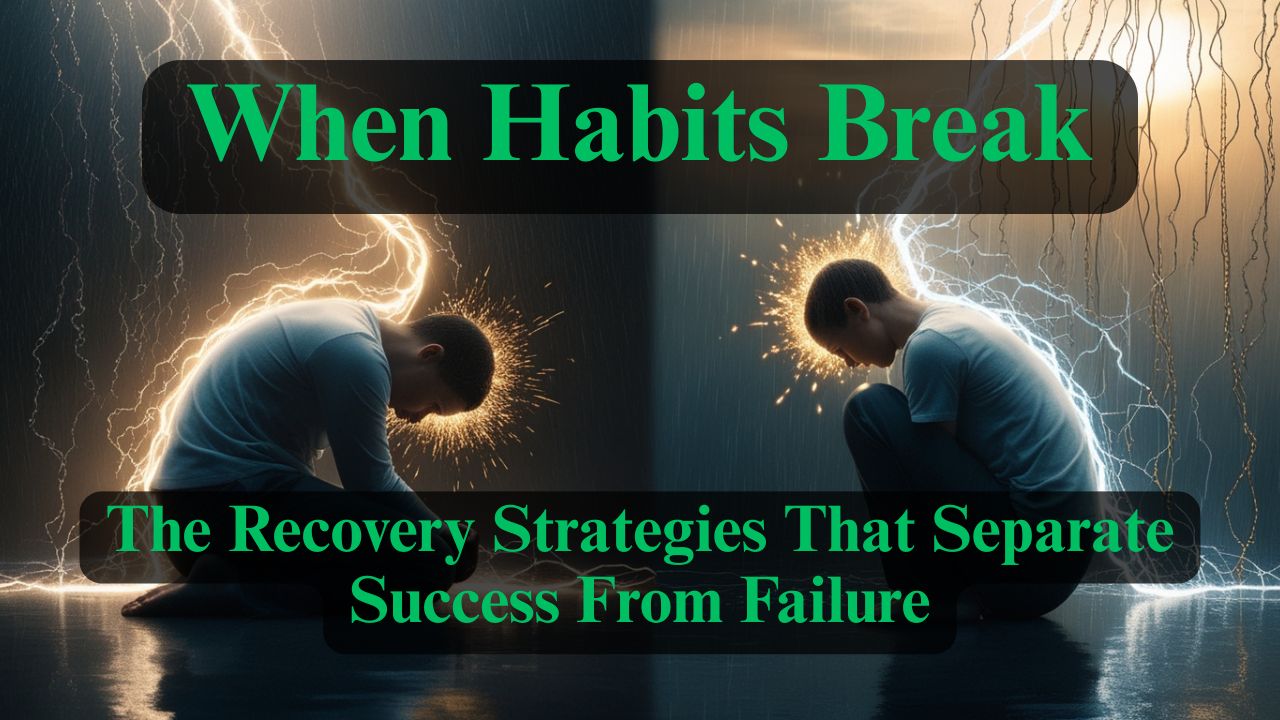Super User
The Art of Self-Control
The Art of Self-Control: Mastering Your Impulses and Taking Charge
Ever watched your carefully laid plans crumble in the face of immediate temptation? Whether it's reaching for that extra slice of cake, spending hours scrolling through social media, or making impulsive purchases, self-control challenges us all. Let's explore how to strengthen this crucial skill.
Understanding Self-Control
Self-control isn't just willpower – it's a complex interplay of habits, environment, and decision-making processes. Think of it as a muscle: it can be strengthened with practice but also becomes fatigued with overuse.
The Science Behind Self-Control
Your brain operates on two systems:
- The immediate gratification system (emotional, impulsive)
- The delayed gratification system (logical, planning)
Understanding this dual nature is crucial for developing better self-control strategies.
Practical Steps to Build Self-Control
1. Start with Environment Design
- Remove temptations from your immediate surroundings
- Create barriers to impulsive behaviors
- Set up your space to support your goals
- Make good choices easier than bad ones
2. Implement the 10-Minute Rule
When faced with an impulse:
- Pause for 10 minutes before acting
- Use this time to evaluate the urge
- Consider long-term consequences
- Often, the urge passes naturally
3. Practice Energy Management
- Recognize that self-control depletes throughout the day
- Handle important decisions when energy is high
- Plan for periods of lower willpower
- Ensure adequate sleep and nutrition
4. Develop Implementation Intentions
Create specific if-then plans:
- "If I feel stressed, then I'll take three deep breaths"
- "If I want to scroll social media, then I'll read for 10 minutes first"
- "If I'm tempted to skip exercise, then I'll just put on my workout clothes"
5. Use the Power of Small Wins
- Start with tiny, manageable challenges
- Build confidence through consistent success
- Gradually increase difficulty
- Celebrate progress, no matter how small
6. Practice Mindfulness
- Develop awareness of your triggers
- Notice impulses without acting on them
- Observe thoughts and urges without judgment
- Create space between stimulus and response
Advanced Strategies
1. Identity-Based Change
- Focus on who you want to become
- Make decisions based on this identity
- Ask "What would someone with strong self-control do?"
- Build habits that align with your desired self
2. Precommitment
- Make binding decisions in advance
- Set up automated systems
- Create accountability structures
- Remove future choice from the equation
3. Strategic Indulgence
- Plan occasional controlled breaks
- Allow structured "cheat days"
- Prevent complete willpower breakdown
- Maintain sustainable long-term control
Common Pitfalls to Avoid
1. All-or-Nothing Thinking
- Perfect control isn't the goal
- Small lapses don't equal failure
- Progress matters more than perfection
- Learn from setbacks rather than giving up
2. Relying Solely on Willpower
- Design systems for success
- Use environmental controls
- Create supportive habits
- Build in accountability
3. Neglecting Recovery
- Allow time for rest and reset
- Recognize willpower fatigue
- Plan for recovery periods
- Maintain sustainable practices
Building Long-Term Success
1. Track Your Progress
- Keep a self-control journal
- Note triggers and successful strategies
- Review and adjust regularly
- Celebrate improvements
2. Create Support Systems
- Share goals with others
- Find accountability partners
- Build a supportive community
- Learn from others' experiences
3. Develop Stress Management
- Have healthy coping mechanisms ready
- Practice regular stress relief
- Maintain emotional balance
- Prevent stress-induced lapses
Taking Action Today
Start with these immediate steps:
1. Identify one area where you want better control
2. Design your environment to support this goal
3. Create one specific implementation intention
4. Practice the 10-minute rule
5. Track your progress for one week
Remember: Self-control isn't about perfect restraint; it's about making conscious choices that align with your long-term goals. Each small victory builds momentum toward lasting change.
The journey to better self-control starts with a single conscious choice. Make that choice today, and watch as small decisions compound into significant life changes.
20 Affirmations for Self-Confidence
20 Affirmations for Self-Confidence
Self-confidence is the foundation of success and happiness. It empowers you to pursue your goals, embrace challenges, and express your true self without fear. Practicing daily affirmations can help you rewire your thoughts and build unwavering confidence from within.
Here are 20 powerful affirmations to boost your self-confidence and create a mindset of strength and positivity.
---
**Affirmations for Building Inner Confidence**
1. I am confident in my abilities and trust myself to succeed.
2. I embrace my uniqueness and recognize my worth.
3. I am capable of handling anything that comes my way.
4. My confidence grows stronger with every step I take.
5. I am proud of who I am and what I have achieved.
6. I release all doubts and welcome self-assurance into my life.
7. I believe in myself and my potential to achieve great things.
8. My confidence inspires others and radiates positivity.
9. I accept myself fully and unconditionally.
10. I am resilient, strong, and courageous.
---
**Affirmations for Overcoming Self-Doubt**
11. I let go of fear and replace it with confidence.
12. I trust my intuition and make decisions with clarity.
13. I forgive myself for past mistakes and learn from them.
14. Challenges help me grow and strengthen my self-belief.
15. I am in control of my thoughts and choose positivity.
16. My confidence is unshakable, even in difficult situations.
17. I deserve success and happiness in all areas of my life.
18. I am not afraid to take risks and step out of my comfort zone.
19. I am the author of my own story and take pride in my journey.
20. I have the power to create the life I desire.
---
**How to Use These Affirmations**
1. **Daily Repetition**: Say your chosen affirmations out loud or write them in a journal each day. Consistency is key.
2. **Visualization**: As you say each affirmation, visualize yourself embodying the confidence and strength described.
3. **Personalize Them**: Adapt these affirmations to align with your specific goals and experiences.
4. **Combine with Action**: Use affirmations to motivate action. Pair them with real steps toward achieving your goals.
---
Conclusion
Confidence begins in the mind. These affirmations serve as reminders of your worth, strength, and potential. By practicing them daily, you can transform your mindset, eliminate self-doubt, and unlock the confidence to live authentically and pursue your dreams fearlessly.
Start today by choosing a few affirmations that resonate with you and make them part of your daily routine. Watch as your inner confidence grows and transforms your life.
20 Affirmations for Wealth, Health and Happiness
20 Affirmations for Wealth, Health, and Happiness
**Affirmations for Wealth**
1. I am open to receiving unlimited abundance.
2. Wealth flows to me in many ways and from multiple sources.
3. I am worthy of financial prosperity and success.
4. Every day, I am becoming more financially secure.
5. My actions create constant wealth, prosperity, and abundance.
6. I have the power to attract wealth and opportunities into my life.
7. Money flows freely to me and through me for the betterment of all.
8. I am grateful for the financial blessings in my life.
9. I am a magnet for abundance and prosperity.
10. My wealth increases as I share and invest wisely.
---
**Affirmations for Health**
11. My body is healthy, vibrant, and strong.
12. I honor my body by nourishing it with healthy food and regular exercise.
13. Every cell in my body is filled with energy and vitality.
14. I am grateful for my strong, resilient body.
15. I choose thoughts and actions that support my physical and mental health.
16. Healing is a natural state for my body, and I embrace it fully.
17. My mind and body are calm, balanced, and at peace.
18. I radiate positive energy and vibrant health.
19. I am in harmony with my body’s natural rhythms and needs.
20. Each day, I grow healthier and stronger.
---
**Affirmations for Happiness**
21. I choose happiness and joy in every moment.
22. My life is filled with love, laughter, and positivity.
23. I am grateful for the small joys that bring me happiness.
24. Happiness is my natural state, and I allow it to flow freely.
25. I focus on the positive, and happiness finds me effortlessly.
26. I deserve to feel joyful and fulfilled.
27. My heart is open, and my happiness radiates to those around me.
28. I release negativity and welcome peace and contentment.
29. I create a life that aligns with my happiness and purpose.
30. Every day, I attract people and experiences that bring me joy.
These affirmations can be spoken aloud, written in a journal, or meditated upon daily to cultivate a mindset of abundance, wellness, and joy.
20 Powerful Affirmations for Daily Motivation
20 POWERFUL AFFIRMATIONS FOR DAILY MOTIVATION
1. "I transform challenges into opportunities for growth"
2. "I am becoming stronger and more capable every day"
3. "I choose action over fear and doubt"
4. "My potential is unlimited, and I choose to realize it"
5. "I am deserving of success and I actively pursue it"
6. "I release old patterns that no longer serve my growth"
7. "Every small step forward brings me closer to my goals"
8. "I trust in my ability to figure things out"
9. "I am resilient in the face of setbacks"
10. "My success benefits not only me but inspires others"
11. "I embrace discomfort as a sign of growth"
12. "My dreams are worthy of my dedication"
13. "I choose progress over perfection"
14. "My past does not define my future"
15. "I am the architect of my own success story"
16. "Each day brings new opportunities for transformation"
17. "I take full responsibility for creating the life I desire"
18. "My actions align with my highest potential"
19. "I celebrate my progress, no matter how small"
20. "I am becoming the person I was meant to be"
Tips for Using These Affirmations:
- Choose 2-3 that resonate most strongly with you
- Write them where you'll see them daily
- Say them aloud during your morning routine
- Use them when facing challenges
- Personalize them to fit your specific goals
- Combine them with visualization
- Add them to your meditation practice
Remember: Affirmations work best when they feel authentic and align with your personal values and goals. They're not just words - they're seeds of transformation that, when combined with action, create real change.
The Power of Affirmations: Rewiring Your Mind for Success

The Power of Affirmations: Rewiring Your Mind for Success
Ever wondered why some people seem unshakeable in their self-belief? The answer might lie in a practice as simple as it is powerful: daily affirmations. Far from being mere positive self-talk, affirmations are scientifically-backed tools for transforming your mindset and, ultimately, your reality.
Understanding How Affirmations Work
At their core, affirmations are positive statements that challenge and overcome negative thoughts and self-sabotaging behaviors. But the science behind them goes deeper. When you repeat affirmations, you're actually rewiring your brain's neural pathways. This process, known as neuroplasticity, allows your brain to form new connections and strengthen belief patterns that support your goals.
The Scientific Foundation
Research in neuroscience shows that self-affirmation activities engage the same reward centers in the brain that respond to other pleasurable experiences. When you affirm positive beliefs about yourself, your brain releases neurotransmitters like dopamine and serotonin, creating a genuine feeling of well-being and motivation.
Why Affirmations Matter
1. Breaking Negative Thought Patterns
Affirmations interrupt the automatic negative thoughts that many of us experience throughout the day. By consciously choosing positive statements, you begin to override these self-limiting beliefs.
2. Creating New Neural Pathways
Regular practice of affirmations creates new neural connections associated with positive self-image and capability. The more you repeat them, the stronger these pathways become.
3. Aligning Actions with Intentions
When you consistently affirm positive beliefs, your actions naturally begin to align with these statements. You start making choices that support your affirmed reality.
Making Affirmations Work for You
The Right Time and Place
Morning practice is particularly powerful, as it sets the tone for your day. However, affirmations can be especially effective when:
- Facing challenges
- Preparing for important events
- Combating negative self-talk
- Making significant decisions
Creating Effective Affirmations
For affirmations to work, they must be:
- Present tense
- Positive
- Personal
- Specific
- Emotionally engaging
- Believable (even if challenging)
Common Mistakes to Avoid
1. Using Negative Language
Instead of "I don't fail at tasks," say "I successfully complete what I start."
2. Future Tense
Replace "I will be confident" with "I am confident."
3. Generic Statements
Make them personal and specific to your goals.
Implementing an Affirmation Practice
Start Small
Begin with 2-3 affirmations that truly resonate with you. Quality trumps quantity when it comes to rewiring your brain.
Make it Routine
Incorporate affirmations into existing habits:
- During your morning coffee
- While brushing your teeth
- Before important meetings
- During exercise
- Before bed
Add Emotion
Feel the truth of your affirmations as you say them. Emotion strengthens the neural pathways you're creating.
Track Your Progress
Keep a journal of how your thoughts and behaviors change over time. This provides evidence of your transformation and reinforces your practice.
Overcoming Skepticism
If you're skeptical about affirmations, start with statements that feel authentic, even if modest. As you see results, gradually stretch your affirmations to align with bigger goals.
The Compound Effect
Like any powerful tool, affirmations work through consistent application. Small daily practice creates compound effects over time, leading to significant shifts in:
- Self-confidence
- Resilience
- Goal achievement
- Emotional well-being
- Decision-making
Moving Forward
Remember that affirmations are not magic pills but tools for transformation. Their power lies in their ability to shift your mindset and, consequently, your actions. When combined with concrete steps toward your goals, they become catalysts for real change.
Start Today
1. Choose one area of your life you want to improve
2. Write 2-3 powerful, positive statements about it
3. Practice them daily for 30 days
4. Notice the shifts in your thoughts and actions
5. Adjust and expand as you grow
Remember: Your mind is incredibly powerful, and affirmations are one of the most accessible tools for harnessing that power. Begin today, and watch as small shifts in your thinking create significant changes in your life.
The journey of transformation begins with the stories you tell yourself. Make them powerful ones.
The Hidden Power Within
The Hidden Power Within
In a world obsessed with external achievements and material strength, we often overlook the most potent force available to us: the power of our thoughts. This innate strength, residing quietly within each of us, holds the key to unlocking our true potential and shaping our reality in ways we might never have imagined.
Most people spend their lives searching for power in the wrong places. They seek it in wealth, physical strength, social status, or authority over others. Yet these external sources of power are temporary and ultimately unsatisfying. True power—lasting, transformative power—emanates from within, beginning with our thoughts.
Our thoughts are not merely passive observations of reality; they are active creators of it. Every great achievement, every technological breakthrough, and every positive change in human history began as a thought in someone's mind. The skyscrapers that pierce our city skylines, the medical innovations that save countless lives, and the social movements that reshape societies—all were first conceived in the realm of thought before manifesting in the physical world.
This internal power source operates through several key mechanisms. First, our thoughts shape our perceptions, determining how we interpret and respond to the world around us. A challenge viewed as an opportunity sparks different actions than one seen as an insurmountable obstacle. Second, thoughts influence our emotional state, which in turn affects our physical well-being and performance. Third, and perhaps most importantly, our thoughts direct our focus and energy, determining what we notice, what we pursue, and ultimately what we achieve.
Consider the athlete who visualizes success before a competition, the entrepreneur who maintains unwavering belief in their vision despite setbacks, or the activist who holds fast to their conviction that change is possible. Their external achievements are preceded and powered by internal thought processes that refuse to accept limitation or defeat.
But if this power is inherent in us all, why do so few seem to harness it effectively? The answer lies in awareness and cultivation. Like a muscle that atrophies without use, our thought power weakens when we neglect it. Society's emphasis on external solutions and instant gratification can lead us to discount the subtle yet profound influence of our internal world.
Developing this inner power requires conscious effort and practice. It begins with awareness—paying attention to our thought patterns and recognizing their impact on our lives. It continues with cultivation—actively choosing thoughts that serve our growth and deliberately replacing those that limit us. This isn't about naive positivity or denying reality; it's about understanding the malleable nature of our experience and taking responsibility for shaping it.
The journey to accessing this hidden power often involves:
1. Regular reflection and meditation to strengthen our connection with our inner world
2. Conscious choice of thoughts and mental images that align with our aspirations
3. Recognition and transformation of self-limiting beliefs
4. Development of mental resilience through challenging circumstances
5. Cultivation of emotional intelligence and self-awareness
The power of thought extends beyond individual achievement. When we understand and harness this internal force, we become better equipped to contribute positively to our communities and the world at large. Our enhanced awareness allows us to respond rather than react, to create rather than merely consume, and to lead through inspiration rather than force.
As we face increasingly complex global challenges, the ability to tap into this inner power becomes not just personally beneficial but collectively crucial. The solutions to many of our world's problems will not come from more external force or control, but from the concentrated, creative power of human thought applied with wisdom and compassion.
The invitation, then, is to turn inward. To recognize that the power we seek has been with us all along, waiting to be acknowledged and developed. In doing so, we might discover that the greatest adventure of our lives is not the conquest of external territories but the exploration and mastery of our inner landscape.
The hidden power within us is not hidden because it is scarce or inaccessible, but because we have been conditioned to look elsewhere. It is time to reclaim this birthright, to remember that our thoughts are not just passive observers of reality but active participants in its creation. In this remembering lies the potential for both personal transformation and collective evolution.
As you read these words, consider: What thoughts are shaping your reality right now? What internal power lies dormant within you, waiting to be awakened? The journey to discovering and harnessing this power begins with a single thought—the thought that perhaps, just perhaps, your greatest source of strength has been within you all along.
How To Control Your Thoughts
How To Control Your Thoughts
Intro: Your thoughts have incredible power over your mental state, emotions, and outlook on life. While you can't always control what thoughts initially pop into your mind, you can learn to better manage your thought patterns. With practice, it's possible to gain more control over your thoughts and inner dialogue. Here are some proven strategies:
1. Practice mindfulness
Mindfulness is the practice of being fully present and aware of your thoughts, feelings and surroundings in the moment. Through mindfulness meditation and exercises, you can train yourself to observe your thoughts without judgment. Over time, this allows you to catch negative thought patterns early and redirect your mind to more positive thoughts. Start with just 5 minutes of mindfulness practice per day.
2. Challenge negative thoughts
Whenever you notice a negative or irrational thought, get in the habit of questioning it. Ask yourself: Is this thought based on facts or feelings? Is it helpful or harmful? What would I say to a friend having this thought? By challenging negative thoughts, you can break their grip and replace them with more balanced, realistic thoughts. Cognitive behavioral therapy uses this technique.
3. Practice gratitude
Consciously focusing your thoughts on the things you're grateful for can shift your mindset in a positive direction. Keep a gratitude journal and write down a few things you're thankful for each day. Appreciate the small joys and pleasures in life. Choose to dwell on the good rather than ruminating on the bad. Gratitude fosters positivity.
4. Use positive affirmations
Positive affirmations are uplifting statements you repeat to yourself to change your thought patterns and beliefs over time. Craft affirmations that are meaningful to you, such as "I am capable of handling any challenge" or "I choose peace and joy." Recite your affirmations daily, ideally out loud and with conviction. Affirmations can rewire your habitual thinking.
5. Visualize success
Your thoughts have the power to shape your reality. Regularly visualize yourself succeeding, thriving and living the life you desire. Make your visualizations as vivid as possible, imagining how you'll feel in that positive future. Let your thoughts create the blueprint that your actions will follow. Visualization is used by top athletes and leaders to achieve their goals.
6. Cultivate healthy distractions
Sometimes the best way to control negative thoughts is to redirect your mind elsewhere. Have some healthy distractions ready, such as playing music, reading an engrossing book, exercising, engaging in a hobby or talking to a friend. Doing something you enjoy can stop the spiral of negative thinking and flood your brain with feel-good chemicals instead.
Conclusion: Learning to control your thoughts is a skill that improves with practice. Be patient with the process. Start implementing these strategies and you'll gradually gain more mastery over your mind. As you do, you'll enjoy greater inner peace, emotional resilience, and a more positive experience of life. Remember, you have the power to choose your thoughts - so choose wisely!
How To Control your Mind
IF - By Rudyard Kipling
Control Your Thoughts
- Audio Articles
- Audio Articles 1
- Audio Articles 2
- Audio Articles 3
- Audio Articles 4

7 Daily Disciplines That Transform Your Life
The power to act with intention, to align your actions with your values, and to move steadily toward a life of purpose—even on days you don't feel like it.
Read Full Article
How to Build Unbreakable Discipline
Discipline is built—habit by habit, choice by choice, day by day. And the most powerful kind? The kind that doesn’t crack under pressure. The kind that becomes part of who you are.
Read Full Article
Why Motivation Fails And Discipline Wins Every Time
We all love the feeling of motivation—that surge of energy, that rush of inspiration that makes everything seem possible. But here’s the problem: motivation is unreliable. It’s emotional. It comes and goes. And if your goals rely on you “feeling like it,” you’re already in trouble.
Read Full Article
Discipline Over Desire
Desire is loud. It burns bright, talks fast, and loves to dream. But desire alone doesn't achieve much. Every person has desires. Very few have the discipline to bring them to life.
Read Full Article
The Science of Sticking
If you've ever tried to build a new habit, you've probably heard that it takes 21 days. This number gets thrown around so often that it feels like scientific fact.
Read Full Article
The Stacking Strategy
What if I told you that the habits you already have—even the ones you consider "bad"—could become the secret weapons for building the habits you want?
Read Full Article
When Habits Fail - The Recovery Strategies That Separate Success From Failure
Here's what nobody tells you about building habits: you will fail. You'll miss days. You'll fall off track. You'll have weeks where everything falls apart.
Read Full Article
The Ultimate System - Designing a Life Where Good Habits Are Inevitable
You've learned to recognize habits, understand their formation timeline, stack them strategically, and recover from setbacks.
Read Full Article




















